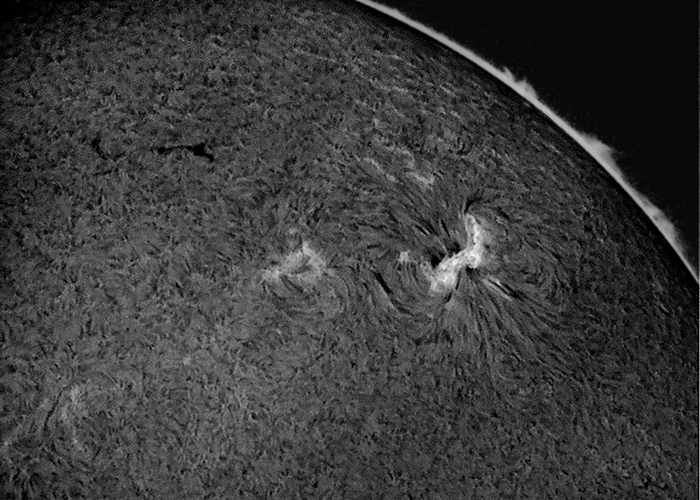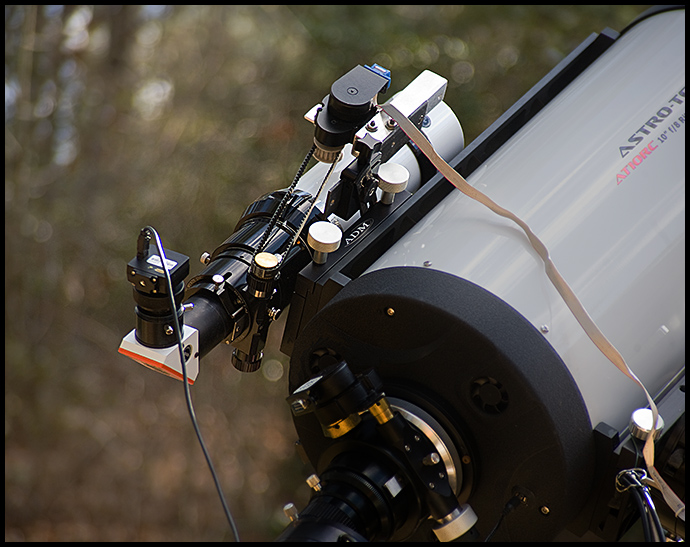|
A comedy of errors ensued. You do this under marginal skies in order not to waste good ones when they come along. I did waste a long clear spell trying to focus on one of the secondary solar images. I didn't know that was what I was doing until I tried tuning the internal echelon for better contrast and the image moved. After recentering on the properly trimmed image, I found focus much more readily. Note that the high-density stream coming from the Chameleon slows the remote desktop app to a crawl. I'm thinking that instead of 15fps, the office computer is showing less than 1fps, and commands are seriously lagged. I had the desktop set to 1280x1024 which is big enough to see almost the entire frame at once. All that probably gives the graphics chipset in the Aspire One more than it wants to handle. Still. Everything works. I had some doubts because FlyCap relies heavily on function keys and interupts; just how well they would be passed through, I wasn't sure. It's not an issue. I used Maxim and the ST2000XM (OTA capped, chip uncooled) just for the "move" commands in the guiding dialog. I panned across the Sun in both axes just to be sure I could. Robofocus never skipped a beat, though I had to reset its limits once. Clouds and encroaching pines made life tough, but all this will work fine when the Sun is higher and the sky clearer. I think I got about a quarter of a second of actual video for 90 minutes of messing around and nothing at all to show here. Think about whether a tolerable balance can be found without the bronze counterweight. It's a bear to switch on and off, but that, too, is manageable. This is going to be great for staring at the Sun. Sitting at my desk is so much more pleasant than standing outside under the black observer's cloak (think of a secular burka) while trying to manage a keypad in one hand and the netbook in the other.
3/04/2012: There are three gaps in the trees that permit the Sun to shine through. The Sun reached the first gap around 8:00 AM, the other two in early afternoon. I needed them all to iron out most of the wrinkles in remote solar imaging. The best tips of the day:
Anyway: we've got it working; now see about making it work elegantly.
Magnetic canopy above sunspot 1429
Clouds, pine boughs, and dreadful seeing plagued every attempt; also a dead computer battery; a RoboFocus mutiny; and another adventure trying to use one of the extraneous solar images rather than the trimmed, on-band image. In mid-afternoon, I finally got a relatively clean capture with only seeing to fuzz the result. That's AR 1429 rotating into view. It's been throwing M-class flares. Even when quiescent, it lofts a complex plasma canopy.
3/05/2012: AR 1429 launched an X1-flare this morning when it was out of view, and an M-flare this afternoon just before emerging into the afternoon gap in the pines. Here it is fifteen minutes after that second blast, still cooling:
AR 1429 a few minutes after an M2-flare
03/6/2012: I took a morning glance at AR 1429 and its quieter neighbor AR 1430. The early morning offered reasonably steady seeing despite the large air mass, but there was not a lot to see -- nothing like yesterday afternoon. Later, the seeiing improved (though not to yesterday's standard) and this is what was going on when the Sun cleared the meridian pines. Does it look to you as if something big is looming beyond the horizon behind this active region? We'll see in a few days.
The outfit for this year is a little different. The Lunt is mounted on the AT10RC with its own RoboFocus motor, both semi-permanently mounted on the Mach1GTO. I've moved a big case to the north end of the trailer (not the little one shown below) with the idea that the AT can be stored for short periods there when the A-P refractor is preferred. It's all part of a plan to avoid carrying heavy, expensive gear around more than necessary.
Robofocus-equipped Lunt Solar Telescope on top of AT10RC
The Nineteenth Fairway — waiting for the Sun to reach
3/10/2011. AR 1429 has been extremely active these last few days, but my sky has not cooperated until today. I tried reducing the image scale by reducing as far as possible the extension between the Barlow and the PGR Chameleon's chip. Not much change as yet, but what there is is for the better. I'd like to reduce the scale more, either with a custom adapter or a less aggressive negative lens. I'll think on that. Today, the air is cooperating and the usually excessive image scale is working out OK. See?
AR1429 cooling from a bright M-flare
Same tech specs.
|
:: top ::
© 2011, David Cortner






